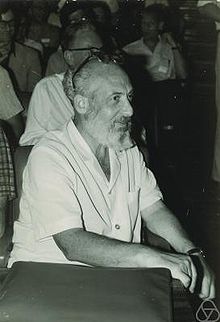Samuel Eilenberg
| Samuel Eilenberg | ||
|---|---|---|
 Samuel Eilenberg en 1970 | ||
| Información personal | ||
| Nacimiento |
30 de septiembre de 1913 Varsovia (Imperio ruso) | |
| Fallecimiento |
30 de enero de 1998 (84 años) Nueva York (Estados Unidos) | |
| Nacionalidad | Estadounidense y polaca | |
| Educación | ||
| Educado en | Universidad de Varsovia (hasta 1936) | |
| Supervisor doctoral | Kazimierz Kuratowski y Karol Borsuk | |
| Información profesional | ||
| Ocupación | Matemático, topólogo, profesor universitario y coleccionista de arte | |
| Área | Topología, matemáticas, coleccionismo y artes visuales | |
| Empleador |
| |
| Estudiantes doctorales | William Lawvere | |
| Obras notables | teorema de Eilenberg-Zilber | |
| Miembro de | ||
| Distinciones |
| |
Samuel Eilenberg (30 de septiembre de 1913-30 de enero de 1998) fue un matemático polaco. Nació en Varsovia (Polonia) y murió en Nueva York (Estados Unidos).
La topología fue su principal interés: trabajó en el tratamiento axiomático de la teoría de la homología con Norman Steenrod, y en el álgebra homológica con Saunders MacLane, escribió un libro sobre el tema anterior con Henri Cartan que llegó a ser un clásico, y tomó parte en los encuentros del grupo Bourbaki. Después se dedicó principalmente a la teoría de las categorías, siendo uno de los fundadores del campo. El telescopio de Eilenberg es una construcción sorprendente, que aplica la idea de la cancelación telescópica a los módulos proyectivos.
Eilenberg también escribió un importante libro sobre teoría de autómatas.
Referencias
[editar]- S.Eilenberg. Autómatas, Lenguajes y Máquinas. ISBN 0-12-234001-9
Véase también
[editar]Enlaces externos
[editar]Text is available under the CC BY-SA 4.0 license; additional terms may apply.
Images, videos and audio are available under their respective licenses.
